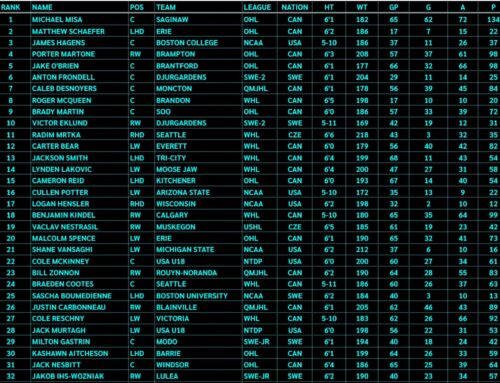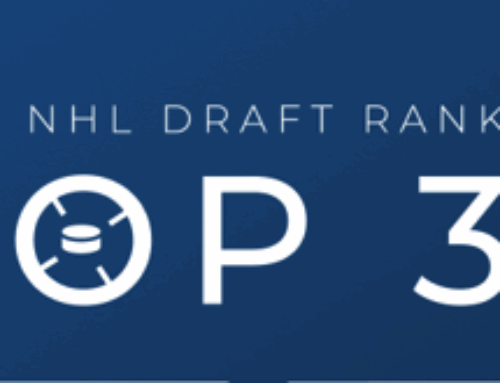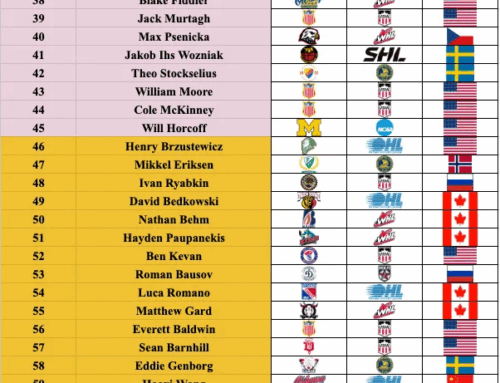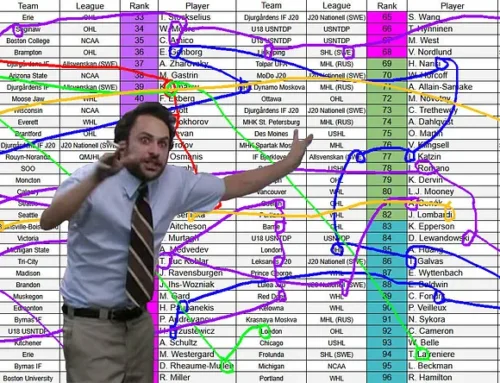PNHLe Organizational Rankings 15 to 11
Mason Black
2019-09-30
(Title photo credit to NHLPA.com and Getty Images)
***
This is the fourth part of a series where I will be ranking NHL organizations based on a new PNHLe model that I have spent the past month updating.
[Editor’s note: this content was created in Mid-September, and does not consider recent pre-season activity]
If you are unfamiliar with PNHLe, or would like a more in-depth explanation on why these rankings are different compared to traditional real-world prospect grades or those explicitly for fantasy purposes, I highly recommend you read through the introduction – heck, why not the whole thing – for the previous parts of the series which you can find here:
PNHLe Organizational Rankings: 20 – 16
PNHLe Organizational Rankings: 25 – 21
PNHLe Organizational Rankings: 31 – 26
Over the past month, I have re-evaluated, recalculated and re-examined my PNHLe model, which is used to predict a prospect’s NHL point potential in the prime of their career.
The culmination of every hockey season brings forth a massive allocation of new data that can be used to make the model more accurate. Many NHL players hit new career highs, while others show consistency in their point production, which allows for minor tweaks to the overall PNHLe formula.
Looking back to the leagues NHL players toiled in prior to making the leap to the NHL can give great insight into what a typical point production looks like for many current prospects playing all over the world.
Simply put, PNHLe tries to gauge a prospects point potential in the NHL. How many points would an 18-year old prospect in the OHL, who posted a point per game, obtain if they make it to the show? PNHLe allows us the ability to compare prospects from different leagues, at different ages and different positions to give a snapshot of just how good they are doing. As a fantasy manager, you can use that knowledge to take advantage and snag a player well before anyone else in your league.
Let us take a look at the next set of rankings:
15th – Vancouver Canucks – PNHLe: 58(Avg.)
One year removed from the graduation of the reigning Calder Trophy winner – Elias Pettersson – the Canucks still have a very deep pool of top end prospects. Vancouver has been very fortunate with the way they’ve staggered the graduation of its players and this should result in a return to the playoffs in the near future, which will ultimately translate into post-season success immediately thereafter.
Quinn Hughes is the next star ready to begin his rookie campaign after a short, albeit sensational, stint in the NCAA. Hughes also had a brief taste of NHL hockey last spring, where he gave fans a glimpse of why it will be hard for them to remain in their seats when he’s on the ice. Another defender that could sneak his way on to the roster is Olli Juolevi who may never live up to the billing of a fifth overall pick, but was off to a fantastic start in Utica before a season ending injury concluded his year. It’s more likely that he’ll take some time readjusting to the pace of the AHL, but if he is able to reacclimatize himself he may get more than a cup of coffee in Vancouver before the end of next season.
Jet Woo followed up a fantastic draft year with a monster campaign in Moose Jaw (WHL) where he eclipsed the point-per-game plateau by scoring 66 points in only 62 games. He plays a very complete game and could be a fantastic addition to fantasy teams that count peripheral statistics down the road. In the meantime, he will look to prove that a change of scenery to the Calgary Hitmen will serve to make him one of the most feared defenders in the entire CHL.
The third round pick from 2018, Tyler Madden, is on a short list of players that have increased their stock as a prospect more than any other in the NHL. Madden made a seamless adjustment to the NCAA on Northeastern University after they were expected to take a step backwards when they lost some key upper-classmen, but he became the sparkplug that much of the offense was built around. A stellar World Junior Championship solidified him as a top prospect, and he will look to build off of last season’s success.
Add in the dominant 10th overall pick, Vasili Podkolzin – who wasn’t included in these rankings based on the different leagues he spent in Russia and no PNHLe translation factor – and it’s clear that Vancouver should be ranked significantly higher in real life prospect charts and should improve in next year’s rankings.
14th – Carolina Hurricanes – PNHLe: 59(Avg.)
As if the ‘surging’ Hurricanes last year was not surprise enough as they catapulted themselves into the Conference Final of the playoffs, while also knocking off the defending Stanley Cup Champions in the process, its farm team in Charlotte outclassed all other AHL teams to win the Calder Cup. Big things could be right around the corner for an organization that has typically been on the outside looking in on the playoff picture, due in large part to the Canes’ salary structure.
Outside of 2017 first round pick, Martin Necas, the Hurricanes strength in prospects resides in the team’s depth and they don’t have many players that project as a first round talent. In fact, there are a handful of players that rank significantly lower in PNHLe compared to their real world potential and Necas is certainly one. I fully expect him to grab a roster spot in Carolina this season and start posting top-six numbers as early as the following year, especially considering the right wing side is relatively thin compared to the rest of the Hurricane’s roster.
The one area that owner Tom Dundon and his recently title General Manager, Don Wadell, have made a significant investment in is the analytics department. Alongside an underrated amateur scouting staff, the Hurricanes have built a talented pool of prospects where many of the players have the potential of finding roster spots in the middle of the line-up. 2019 first round selection, Ryan Suzuki, is a talented play-maker despite needing more time to develop compared to some other prospects selected around him. Stelio Mattheos is a player that I have been high on for quite some time and now is the time he’ll need to show his consistent production in the WHL is suited for a scoring role at the professional level. Mattheos will suit up for the Checkers this season.
Jake Bean is NHL ready, but will find it difficult to earn ice-time in one of the most complete defensive units in the entire NHL. Overall, Carolina is a team on the verge of pushing to the top of the Metropolitan Division, but they will be in tough against some other teams that made serious improvements recently and are going to make the playoff push a difficult one once again.
13th – Pittsburgh Penguins – PNHLe: 59.4(Avg.)
Admittedly, I did a double take when I saw just how high the Penguins soared up this rankings list as I would probably project them to be in the bottom-five of the entire league if I was to go through the same process without using PNHLe. Nonetheless, it paints a fairly clear picture of what the Penguins have prioritized in terms of its prospects as they are willing to use the same recipe for success that has worked in the past: try to hit home-runs with boom or bust players that can sufficiently play alongside two of the NHL’s best centres. It has worked before and there is no reason to believe it can’t work again as the aging curve suggests there aren’t as many more kicks at the Stanley Cup can as there once were.
There is very little risk taking a player like Nathan Legare in the third round and the fact that he can find the back of the net like almost nobody else in his draft class suggests he probably should have went at least a round earlier, but his unorthodox skating style more than likely prevented that from happening. Two rounds earlier the Penguins selected Samuel Poulin with Pittsburgh’s first round pick. Poulin is a player that does just about everything right and has flashes of top end skill, but never really brought it on a consistent enough basis. This year will be a very important one for him, as the Penguins fully expect that he is in the initial stages of development and still has a lot more to give moving forward.
It’s probably time for the Penguins to start thinking about grooming the heir apparent to Kris Letang’s spot anchored on the top power-play unit. If I were a betting man, I’d put my money on Calen Addison. Don’t get me wrong, he’s never going to post Letang’s numbers, and the fact that he didn’t improve on last year’s totals is a bit of a red flag, However, I don’t really see another defenseman in the system that is capable enough of quarterbacking the top special teams unit. The next best candidate is more than likely recently acquired Pierre-Olivier Joseph from the Arizona Coyotes. He hasn’t dominated as much as early projections suggested that warranted a first round selection in 2017, but he certainly has NHL upside.
12th – Detroit Red Wings – PNHLe: 59.8(Avg.)
In Ken Holland’s last year at the draft table for the ‘Winged Wheel’ he seemed to steal player after player and that has quickly vaulted them up the prospect standings. Couple recent draft success with some top-notch NCAA signings and the rebuild in Motown will not take too long.
Filip Zadina is Detroit’s clear-cut top prospect and was expected to go top-three before a draft day tumble landed him at sixth overall. Although his numbers look less than stellar during rookie season in the AHL, stats alone can be misleading which has led to a lower PNHLe. I really think Zadina has first line talent written all over him and will jump back to the forefront of prospect rankings early on this season, whether he cracks the Red Wings line up or spends more time in Grand Rapids.
Former QMJHL exceptional status recipient, Joe Veleno, is another player whose stock mysteriously fell on draft day, and Detroit was more than happy to snag him at the end of the first round. He’s always shown bubble first line offensive potential due to the fact he’s responsible in both ends of the rink, but this year he exploded and is beginning to look like he’s a can’t miss top-line prospect. The fact that Detroit already has its first line pivot locked up in Dylan Larkin makes a 1a/1b deployment more than enviable.
You may have noticed that Detroit’s sixth overall pick from this year’s draft, Moritz Seider, is absent from this ranking, but the German Elite League isn’t tracked for PNHLe based on the fact there are not enough player comparables to help build a pattern of success and potential. I’ll be honest, I didn’t see a lot of him in action this past year, so his upside is unpredictable, but you have to trust Yzerman’s experience along with that of Detroit’s scouting staff. I did, however, catch a few of the Wings’ games in Traverse City and he looked like one of the more mature players despite his age, and showed glimpses of offensive potential.
After a ridiculous run of consecutive playoff appearances, the Red Wings finally have to implement a rebuild, but the likes of which is already well under way. They have some core pieces locked up which bodes well for Detroit’s future post-season chances and a quick turnaround will have them knocking on the playoff door sooner than later.
11th – Calgary Flames – PNHLe: 60.4(Avg.)
A phenomenal regular season last year for the Flames had to make an early exit in the playoffs sting a little bit more than usual. Fortunately, they have a wealth of talent that is close to making a big impact on an already impressive roster. The off-season injury to Juuso Valimaki surely hurts, but when one door closes another opens and that will give an opportunity to a young defender to grab an otherwise locked up roster spot.
Oliver Kylington seems to be the immediate beneficiary of the Valimaki injury, and – along with Rasmus Andersson – is on the verge of becoming career NHLer. The tough break to the Flames’ back end could expedite their development as both saw significant NHL time last season. Valimaki has the highest upside of the three but it has had many counting Kylington out for far too long, where he could make for a really sneaky depth add to your fantasy roster.
I am extremely high on Dillon Dube and believe he has all the makings to become the next Flames captain once Giordano retires. He’ll have some tough competition to earn that distinguished honour, but he is already so mature for his age and the output will eventually come for the talented pivot. I see him eventually carving out a role on the second line, but may make it too difficult for Flames’ coaches to keep him away from the top power play unit. At the very least he should be running the second unit in a couple years, yet will be in tough competition this season to earn a full-time roster spot.
Calgary added a diminutive left-winger at 26th overall when they selected Jakob Pelletier at the end of the first round. He had a monster year for the Moncton Wildcats this season and posted the third highest PNHLe for draft eligible prospects in the entire CHL. I do see some flags that warrant attention because much of what made him such a prolific scorer will not translate very easily to the NHL, but his compete level may be enough to get his foot in the door.
If you have enjoyed today’s breakdown of using PNHLe to predict a prospect’s future success at the NHL level, please stay tuned as I complete an article once per month here at Dobber Prospects, while also covering the players in Vegas Golden Knight’s system.
I have also created the NHL Rank King app where you can find full organizational point totals for prospects, PNHLe rankings among many other fantasy resources. I consult the app on every fantasy hockey decision I evaluate and every feature added to the app is with the sole purpose of helping with the choices surrounding my fantasy hockey teams. It’s completely free, so hopefully you will find it useful as well!
You can download the iPhone version here, and I have recently created an Android version as well.
If you are on Twitter, please give me a follow @NHLRankKing.












